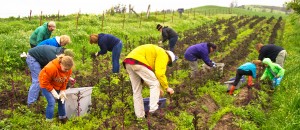CropMobster grew organically, like everything else at Sonoma County’s Bloomfield Farms. The website connects individuals and nonprofits with food producers who offer items for deep discount or donation and, in the process, help tackle the perennial problem of waste.

“Food insecurity, farmer insecurity, waste and then the transfer of knowledge to the next generation," said Nick Papadopoulos, the family farm's general manager. "I see those as some of the four biggest issues we face, and that’s what we’re experimenting with at Bloomfield Farms.”
The idea is that anyone in the local food business can sign up to post big lots of products. Anyone can also sign up to receive the alerts – individuals, nonprofits, restaurants. Papadopoulos’ co-founders include farmers and technologists.
Since the site started six weeks ago, Papadopoulos said it has hooked up more than 11,000 pounds of farm produce with everyone from food banks to groups of neighbors getting together for a meal.
The site doesn’t just deal in crops. The Sonoma Humane Society used CropMobster to find homes for 30 egg-laying chickens at risk of being put to sleep. And a grass-fed cattle ranch sold 100 pounds of bones for stock. There also have been deals on used irrigation tape and young strawberry plants. A USDA Agricultural Resource Management Survey in 2011 highlighted the tight financial spot that small farms in California are in, said Shermain Hardesty, the leader of UC's Small Farm Program. Hardesty said the survey found the average net cash farm income for small family farms in California was just $9,403.